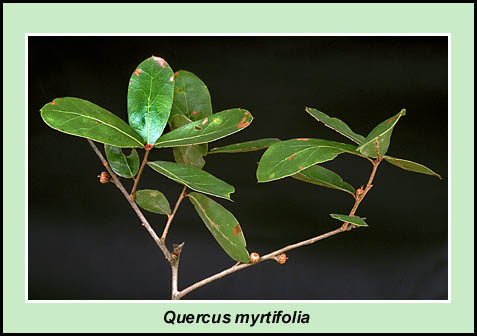Myrtle Oak
Quercus myrtifolia
Family: Fagaceae
Natural History

Myrtle oak, sometimes called shrubby oak, is a small, evergreen tree that often grows into unusual, contorted forms due to exposure to coastal winds. It resprouts easily from rhizomous roots and frequently grows into dense thickets. Its regenerative ability makes it quick to recover after a fire.
While there is no real commercial value for the wood of myrtle oak, some folk legends attribute magical powers to the plants that are believed to bestow love, passion, and fertility upon the users.
The acorns from myrtle oak are ready early in the season and provide an important source of food for many wildlife. The high carbohydrate, high fat nuts are eaten by wild turkey, quail, squirrels, raccoons, black bear, deer, and numerous rodents. The dense, thickets provide excellent nesting and cover sites for birds, including the Florida scrub jay, an endangered species.
Myrtle oak is usually found close to salt water along the sandy ridges on the shorelines and islands from South Carolina, throughout coastal Florida, and west into Mississippi. Other species associated with myrtle oak include sand pine, longleaf pine, Chapman oak, sand live oak, and laurel oak.
